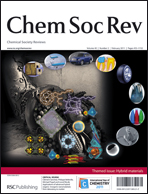Organo–silica hybrid functional nanomaterials: how do organic bridging groups and silsesquioxane moieties work hand-in-hand?†
Abstract
Bridged polysilsesquioxanes (BPS) are a class of versatile functional hybrid materials with tunable chemical, physical and mechanical properties. This tutorial review describes recent advances of these functional hybrid nanomaterials. The review includes control of factors affecting nanometre scale morphology, the preparation of spherical hybrid

- This article is part of the themed collection: Hybrid materials

 Please wait while we load your content...
Please wait while we load your content...